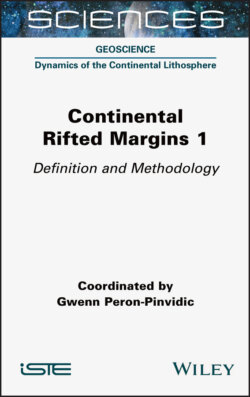Continental Rifted Margins 1

Реклама. ООО «ЛитРес», ИНН: 7719571260.
Оглавление
Gwenn Peron-Pinvidic. Continental Rifted Margins 1
Table of Contents
List of Tables
List of Illustrations
Guide
Pages
Continental Rifted Margins 1. Definition and Methodology
Preface
How to use this book
Overview
Color code and geological timescale
Acknowledgments
1. What is Rifting? Introduction and Basic Definitions
1.1. Introduction
1.2. Rift classifications
1.2.1.Rift mechanism classification: active versus passive rifting
1.2.2. Plate tectonic setting classification
1.2.2.1. Intracontinental rifts
Narrow intracontinental rifts
Case example: The East African Rift
The aulacogen case
Wide intracontinental rifts
Case example: The Basin and Range Province
Intracratonic rifts
Case example: The Congo Basin
1.2.2.2. Rifts at convergent plate boundaries
1.2.2.3. Rifts at divergent-plate boundaries
1.3. Structural features associated with continental rifting
1.3.1. Extensional mechanisms
1.3.2. Main structural geometries
1.3.2.1. Normal faults
1.3.2.2. Detachment faults
1.3.2.3. Shear zones
1.3.2.4. Metamorphic core complexes
1.3.2.5. Boudinage structures
1.3.2.6. Folds
1.3.3. Main basin types
1.3.3.1. Grabens, half-grabens and horsts
1.3.3.2. Pull-apart basins
1.3.3.3. Sag basins
1.3.3.4. Linkage of rift faults and basins
1.4. Subsidence
1.5. Rift-related materials. 1.5.1. Sediments
1.5.2. Salt. Section written in collaboration with Mark Rowan
1.5.3. Magma
1.6. References
2. What is a Rifted Margin? From the Early Models to Modern Views and Future Challenges
2.1. What is interesting about studying rifted margins?
2.2. Morphological definition
2.3. Classification schemes for rifted margins
2.3.1. Classifications based on the extensional context: the divergent, sheared and transtensional rifted margins. Theory
Evaluation
2.3.2. Classifications based on the amount of magma involved: the volcanic and non-volcanic rifted margins. Theory
Evaluation
2.3.3. Classifications based on sediment volume: sediment-rich and sediment-starved rifted margins. Theory
Evaluation
2.4. Historical review of how our understanding of rifted margins evolved
2.4.1. The pioneering models
2.4.1.1. The pure shear model: McKenzie 1978
2.4.1.2. The simple shear model: Wernicke 1985
2.4.2. The evolution of knowledge
2.4.2.1. Rift models applied to rifted margins: the upper-plate/lower-plate distinction
2.4.2.2. The upper-plate paradox and depth-dependent extension
2.4.2.3. The deformation mode approach
The Whitmarsh et al. (2001) model
The Lavier and Manatschal (2006) model
2.4.2.4. The ductile deformation approach
2.4.2.5. The faulting approach
The polyphase faulting model
The sequential faulting model
The flipping fault model
The fault interaction model
The fault breakaway model
The detachment factory model
2.5. Continental rifted margins
2.5.1. Structural domains
2.5.1.1. The proximal domain. Theory
Evaluation
2.5.1.2. The necking domain. Theory
Evaluation
2.5.1.3. The distal domain. Theory
Evaluation
2.5.1.4. The outer domain. Theory
Evaluation
2.5.1.5. The oceanic domain. Theory
Evaluation
2.5.1.6. Continental ribbons and microcontinents
Continental ribbons
Microcontinents
2.5.2. The 3D perspective
2.5.3. The parameters influencing rift evolution
2.6. Future research
2.6.1. Question 1: What is early rifting?
2.6.2. Question 2: What is final rifting?
2.6.3. Question 3: What is breakup?
2.6.4. Question 4: What is the COB?
2.6.5. Question 5: Why are rifted margins segmented?
2.7. References
Summary of Contributions
3. How Can We Identify and Study Remnants of Rifted Margins in Orogens?
3.1. Introduction
3.2. Brief considerations on orogens
3.2.1. Structure of an orogen
3.2.2. The significance of Ophiolitic assemblages
3.2.3. Classification and types of orogens
3.3. Identifying fossil-rifted margins in orogenic systems: principles and criteria
3.3.1. Identification of coherent tectonic units
3.3.2. Sedimentary/stratigraphic record and depositional environments
3.3.3. Basement lithology and evolution
3.3.4. Rift-related deformation style: classical rift geometries versus supra-detachment basins
3.4. Application to case studies
3.4.1. Recognition of a proximal domain: the case study of the Dauphinois Unit in the Western Alps
3.4.2. Recognition of necking zones: the case studies of the Campo-Grosina Units (Alps) and Southern part of Mauléon Basin (Pyrenees)
The Campo-Grosina Units (Alps): basement record
The Southern part of the Mauléon Basin (Pyrenees): deformation style and stratigraphic record
3.4.3. Recognition of hyper-extended domains: the case studies of the Senadhja Nappe (Rif belt)
3.5. Conclusion
3.6. Acknowledgments
3.7. References
4. What Can We Learn from Marine Geophysics to Study Rifted Margins?
4.1. Geophysical methods
4.1.1. Seismic imaging
4.1.1.1. Multichannel deep seismic. 4.1.1.1.1. Acquisition
4.1.1.1.2. Data processing
4.1.1.1.3. Observation and interpretation
4.1.1.2. Seismic refraction
4.1.1.2.1. Principle
4.1.1.2.2. Acquisition
4.1.1.2.3. Data processing
4.1.1.2.4. Resolution assessment
4.1.1.2.5. Interpretation
4.1.2. Potential field methods
4.1.2.1. Gravity anomalies. 4.1.2.1.1. Acquisition
4.1.2.1.2. Data processing
4.1.2.1.3. Modeling and interpretation
4.1.2.2. Magnetic anomalies. 4.1.2.2.1. Acquisition and processing
4.1.2.2.2. Modeling and interpretation
4.2. Understanding continental rifted margins using geophysics. 4.2.1. Geological objects interpretation
4.2.1.1. Moho interface
4.2.1.2. Magmatic additions
4.2.1.3. High velocity/density bodies (HVDB)
4.2.1.4. Sedimentary units
4.2.1.5. Unconformities
4.2.2. Data complementarity
4.3. Conclusion
4.4. Acknowledgment
4.5. References
5. Numerical Modeling of Rifting: An Overview
5.1. Introduction
5.2. A brief historical introduction to numerical modeling of rifting
5.3. Dynamic modeling: description and formulation. 5.3.1. Eulerian and Lagrangian frameworks
5.3.2. Governing equations
5.3.3. Rheological models
5.3.4. Strain softening
5.3.5. Initial and boundary conditions
5.3.6. Initial weaknesses
5.4. Dynamic modeling: applications
5.4.1 Margin width and extension mode
5.4.2. Normal fault geometry
5.4.3. Symmetric and asymmetric margins
5.4.4. Melting and serpentinization
5.4.5. Surface processes
5.5. Summary and future perspectives
5.6. References
6. Analogue Modeling of Continental Rifting: An Overview
6.1. Introduction
6.2. Methodology
6.2.1. Scaling principles
6.2.2. Materials
6.2.3. General experimental setups and boundary conditions
6.2.4. Model analysis techniques
6.3. Model application
6.3.1. A 2D perspective on rifting. 6.3.1.1. Normal fault development in the upper crust
6.3.1.2. Brittle-viscous crustal scale models
6.3.1.3. Lithospheric scale models
6.3.2. Exploring 3D rift processes
6.3.2.1. Oblique extension
6.3.2.2. Rift segment interaction
6.3.2.3. Rotational rifting and rift propagation
6.4. Summary, challenges and future opportunities
6.5. Acknowledgments
6.6. References
List of Authors
Index
A, B
C, D
E, F
G, H
I, L
M, N
O, P
R, S
T, U, W
Summary of Volume 2
WILEY END USER LICENSE AGREEMENT
Отрывок из книги
Geoscience, Field Director – Yves Lagabrielle
.....
Lister, G.S., Etheridge, M.A., Symonds, P.A. (1991). Detachment models for the formation of passive continental margins. Tectonics, 10(5), 1038–1064.
Longwell, C.R. (1945). Low-angle normal faults in the Basin and Range Province. EOS Transactions American Geophysical Union, 26, 107–118.
.....